Paper Menu >>
Journal Menu >>
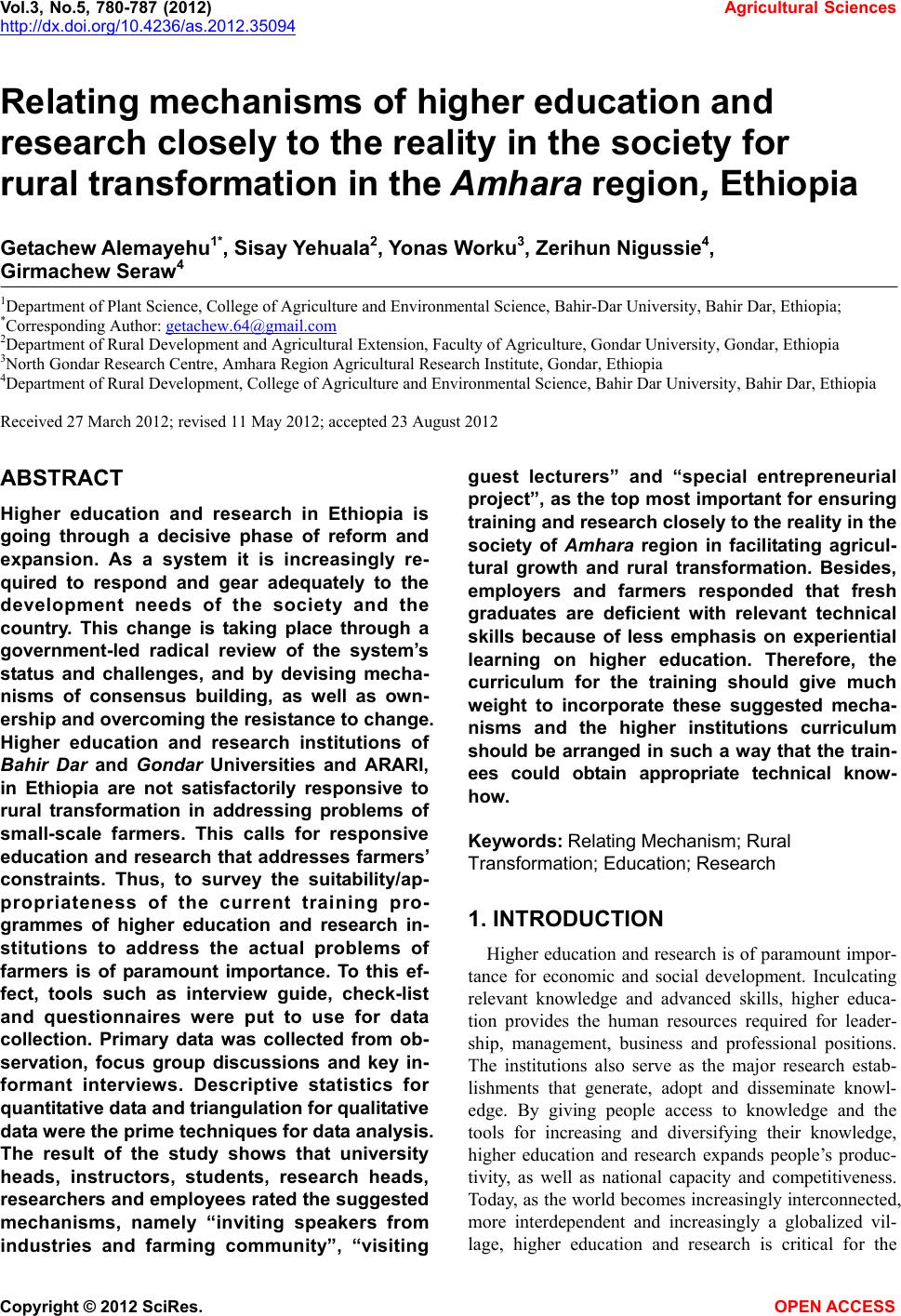 Vol.3, No.5, 780-787 (2012) Agricultural Sciences http://dx.doi.org/10.4236/as.2012.35094 Relating mechanisms of higher education and research closely to the reality in the society for rural transformation in the Amhara region, Ethiopia Get achew Alemayehu1*, Sisay Yehuala2, Yonas Worku3, Zerihun Nigussie4, Girmachew Seraw4 1Department of Plant Science, College of Agriculture and Environmental Science, Bahir-Dar University, Bahir Dar, Ethiopia; *Corresponding Author: getachew.64@gmail.com 2Department of Rural Development and Agricultural Extension, Faculty of Agriculture, Gondar University, Gondar, Ethiopia 3North Gondar Research Centre, Amhara Region Agricultural Research Institute, Gondar, Ethiopia 4Department of Rural Development, College of Agriculture and Environmental Science, Bahir Dar University, Bahir Dar, Ethiopia Received 27 March 2012; revised 11 May 2012; accepted 23 August 2012 ABSTRACT Higher education and research in Ethiopia is going through a decisive phase of reform and expansion. As a system it is increasingly re- quired to respond and gear adequately to the development needs of the society and the country. This change is taking place through a government-led radical review of the system’s status and challenges, and by devising mecha- nisms of consensus building, as well as own- ership and overcoming the resistance to change. Higher education and research institutions of Bahir Dar and Gondar Universities and ARARI, in Ethiopia are not satisfactorily responsive to rural transformation in addressing problems of small-scale farmers. This calls for responsive education and research that addresses farmers’ constraints. Thus, to survey the suitability/ap- propriateness of the current training pro- grammes of higher education and research in- stitutions to address the actual problems of farmers is of paramount importance. To this ef- fect, tools such as interview guide, check-list and questionnaires were put to use for data collection. Primary data was collected from ob- servation, focus group discussions and key in- formant interviews. Descriptive statistics for quantit ative dat a and tria ngulation for qualitative data were the p ri me t ec hniques for data analysis. The result of the study shows that university heads, instructors, students, research heads, researchers and employees rated the suggested mechanisms, namely “inviting speakers from industries and farming community”, “visiting guest lecturers” and “special entrepreneurial project”, as the top most important for ensuring training and research closely to the reality in the society of Amhara region in facilitating agricul- tural growth and rural transformation. Besides, employers and farmers responded that fresh graduates are deficient with relevant technical skills because of less emphasis on experiential learning on higher education. Therefore, the curriculum for the training should give much weight to incorporate these suggested mecha- nisms and the higher institutions curriculum should be arranged in such a way that the train- ees could obtain appropriate technical know- how. Keywords: Relating Mechanism; Rural Transformati on; E duc at ion; Research 1. INTRODUCTION Higher education and research is of paramount impor- tance for economic and social development. Inculcating relevant knowledge and advanced skills, higher educa- tion provides the human resources required for leader- ship, management, business and professional positions. The institutions also serve as the major research estab- lishments that generate, adopt and disseminate knowl- edge. By giving people access to knowledge and the tools for increasing and diversifying their knowledge, higher education and research expands people’s produc- tivity, as well as national capacity and competitiveness. Today, as the world becomes increasingly interconnected, more interdependent and increasingly a globalized vil- lage, higher education and research is critical for the Copyright © 2012 SciRes. OPEN ACCESS 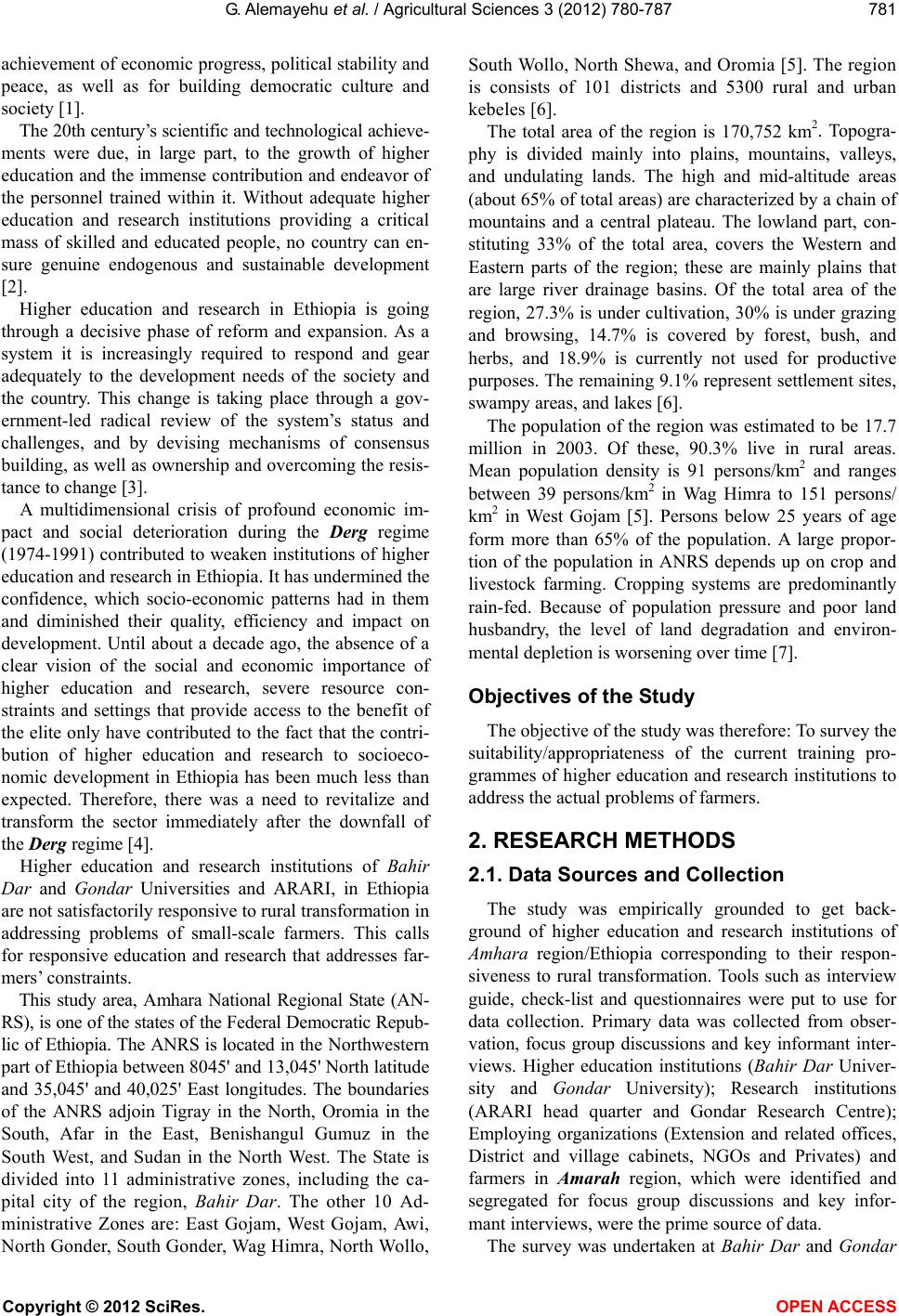 G. Alemayehu et al. / Agricultural Sciences 3 (2012) 780-787 781 achievement of economic progress, political stability and peace, as well as for building democratic culture and society [1]. The 20th century’s scientific and technological achieve- ments were due, in large part, to the growth of higher education and the immense contribution and endeavor of the personnel trained within it. Without adequate higher education and research institutions providing a critical mass of skilled and educated people, no country can en- sure genuine endogenous and sustainable development [2]. Higher education and research in Ethiopia is going through a decisive phase of reform and expansion. As a system it is increasingly required to respond and gear adequately to the development needs of the society and the country. This change is taking place through a gov- ernment-led radical review of the system’s status and challenges, and by devising mechanisms of consensus building, as well as ownership and overcoming the resis- tance to change [3]. A multidimensional crisis of profound economic im- pact and social deterioration during the Derg regime (1974-1991) contributed to weaken institutions of higher education and research in Ethiopia. It has undermined the confidence, which socio-economic patterns had in them and diminished their quality, efficiency and impact on development. Until about a decade ago, the absence of a clear vision of the social and economic importance of higher education and research, severe resource con- straints and settings that provide access to the benefit of the elite only have con tributed to the fact that the con tri- bution of higher education and research to socioeco- nomic development in Ethiopia has been much less than expected. Therefore, there was a need to revitalize and transform the sector immediately after the downfall of the Derg regime [4]. Higher education and research institutions of Bahir Dar and Gondar Universities and ARARI, in Ethiopia are not satisfactorily responsive to rural transformation in addressing problems of small-scale farmers. This calls for responsive education and research that addresses far- mers’ constraints. This study area, Amhara National Regional State (AN- RS), is one of the states of the Federal Democratic Repub- lic of Ethiopia. The ANRS is loca ted in the N orth west ern part of Ethiopia between 8045' an d 13,04 5 ' North latitude and 35,045' and 40,025' East longitudes. The boundaries of the ANRS adjoin Tigray in the North, Oromia in the South, Afar in the East, Benishangul Gumuz in the South West, and Sudan in the North West. The State is divided into 11 administrative zones, including the ca- pital city of the region, Bahir Dar. The other 10 Ad- ministrative Zones are: East Gojam, West Gojam, Awi, North Gonder, South Gonder, Wag Himra, North Wollo, South Wollo, North Shewa, and Oromia [5]. The region is consists of 101 districts and 5300 rural and urban kebeles [6]. The total area of the region is 170,752 km2. Topogra- phy is divided mainly into plains, mountains, valleys, and undulating lands. The high and mid-altitude areas (about 65% of total areas) are characterized by a chain of mountains and a central plateau. The lowland part, con- stituting 33% of the total area, covers the Western and Eastern parts of the region; these are mainly plains that are large river drainage basins. Of the total area of the region, 27.3% is under cultivation, 30% is under grazing and browsing, 14.7% is covered by forest, bush, and herbs, and 18.9% is currently not used for productive purposes. The remaining 9.1% represent settlement sites , swampy areas, and lakes [6]. The population of the region was estimated to be 17.7 million in 2003. Of these, 90.3% live in rural areas. Mean population density is 91 persons/km2 and ranges between 39 persons/km2 in Wag Himra to 151 persons/ km2 in West Gojam [5]. Persons below 25 years of age form more than 65% of the population. A large propor- tion of the population in ANRS depends up on crop and livestock farming. Cropping systems are predominantly rain-fed. Because of population pressure and poor land husbandry, the level of land degradation and environ- mental depletion is worsening over time [7]. Objectives of the Study The objective of the study was therefore: To survey the suitability/appropriateness of the current training pro- grammes of higher education and research institutions to address the actual problems of farmers. 2. RESEARCH METHODS 2.1. Data Sources and Collection The study was empirically grounded to get back- ground of higher education and research institutions of Amhara region/Ethiopia corresponding to their respon- siveness to rural transformation. Tools such as interview guide, check-list and questionnaires were put to use for data collection. Primary data was collected from obser- vation, focus group discussions and key informant inter- views. Higher education institutions (Bahir Dar Univer- sity and Gondar University); Research institutions (ARARI head quarter and Gondar Research Centre); Employing organizations (Extension and related offices, District and village cabinets, NGOs and Privates) and farmers in Amarah region, which were identified and segregated for focus group discussions and key infor- mant interviews, were the prime source of data. The survey was undertaken at Bahir Dar and Gondar Copyright © 2012 SciRes. OPEN ACCESS 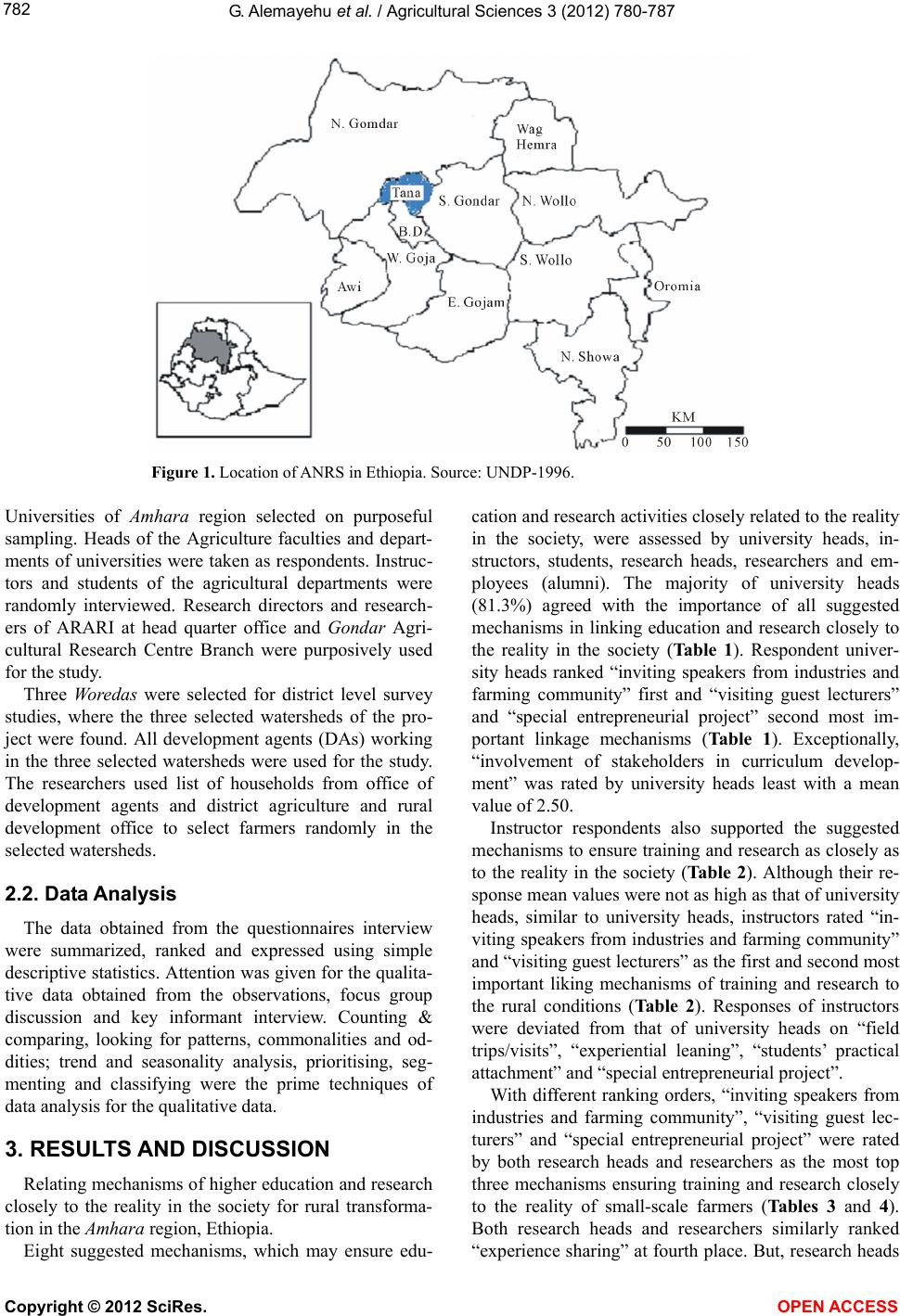 G. Alemayehu et al. / Agricultural Sciences 3 (2012) 780-787 Copyright © 2012 SciRes. 782 Figure 1. Location of ANRS in Ethiopia. Source: UNDP-1996. Universities of Amhara region selected on purposeful sampling. Heads of the Agriculture faculties and depart- ments of universities were taken as respondents. Instruc- tors and students of the agricultural departments were randomly interviewed. Research directors and research- ers of ARARI at head quarter office and Gondar Agri- cultural Research Centre Branch were purposively used for the study. Three Wore da s were selected for district level survey studies, where the three selected watersheds of the pro- ject were found. All development agents (DAs) working in the three selected watersheds were used for the study. The researchers used list of households from office of development agents and district agriculture and rural development office to select farmers randomly in the selected watersheds. OPEN ACCESS 2.2. Data Analysis The data obtained from the questionnaires interview were summarized, ranked and expressed using simple descriptive statistics. Attention was given for the qualita- tive data obtained from the observations, focus group discussion and key informant interview. Counting & comparing, looking for patterns, commonalities and od- dities; trend and seasonality analysis, prioritising, seg- menting and classifying were the prime techniques of data analysis for the qualitative data. 3. RESULTS AND DISCUSSION Relating mechanisms of higher education and research closely to the reality in the society for rural transforma- tion in the Amhara region, Ethiopia. Eight suggested mechanisms, which may ensure edu- cation and research activities closely related to the reality in the society, were assessed by university heads, in- structors, students, research heads, researchers and em- ployees (alumni). The majority of university heads (81.3%) agreed with the importance of all suggested mechanisms in linking education and research closely to the reality in the society (Ta bl e 1 ). Respondent univer- sity heads ranked “inviting speakers from industries and farming community” first and “visiting guest lecturers” and “special entrepreneurial project” second most im- portant linkage mechanisms (Table 1). Exceptionally, “involvement of stakeholders in curriculum develop- ment” was rated by university heads least with a mean value of 2.50. Instructor respondents also supported the suggested mechanisms to ensure training and research as closely as to the reality in the society (Tab le 2). Although their re- sponse mean values were not as high as that of university heads, similar to university heads, instructors rated “in- viting speakers from industries and farming community” and “visiting guest lecturers” as the first and second most important liking mechanisms of training and research to the rural conditions (Table 2). Responses of instructors were deviated from that of university heads on “field trips/visits”, “experiential leaning”, “students’ practical attachment” and “special entrepreneurial project”. With different ranking orders, “inviting speakers from industries and farming community”, “visiting guest lec- turers” and “special entrepreneurial project” were rated by both research heads and researchers as the most top three mechanisms ensuring training and research closely to the reality of small-scale farmers (Tables 3 and 4). Both research heads and researchers similarly ranked “experience sharing” at fourth place. But, research heads 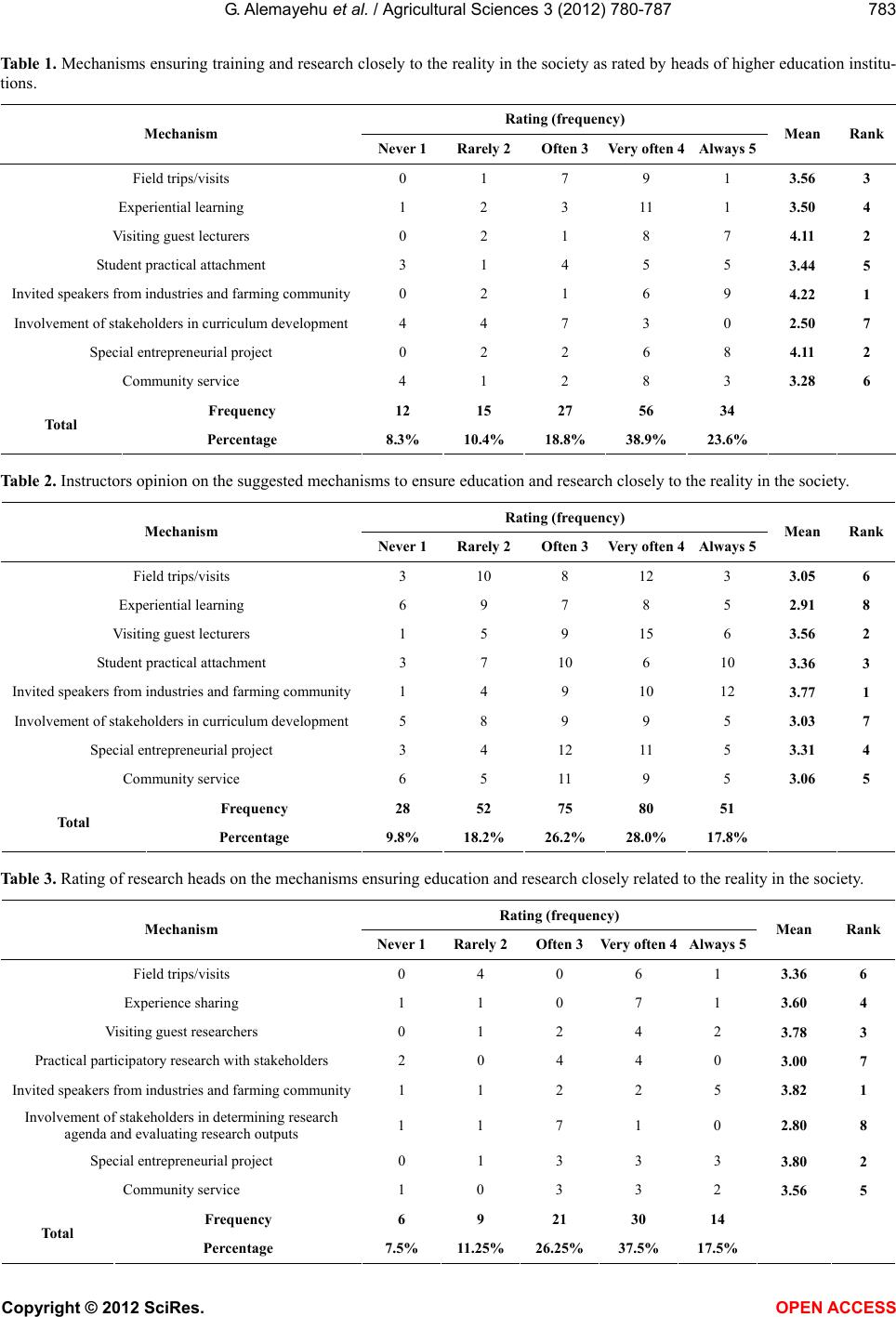 G. Alemayehu et al. / Agricultural Sciences 3 (2012) 780-787 783 Table 1. Mechanisms ensuring training and research closely to the reality in the society as rated by heads of higher education institu- tions. Rating (frequency) Mechanism Never 1 Rarely 2Often 3 Very often 4 Always 5 Mean Rank Field trips/visits 0 1 7 9 1 3.56 3 Experiential learning 1 2 3 11 1 3.50 4 Visiting guest lecturers 0 2 1 8 7 4.11 2 Student practical attachment 3 1 4 5 5 3.44 5 Invited speakers from industries and farming community 0 2 1 6 9 4.22 1 Involvement of stakeholders in curriculum development 4 4 7 3 0 2.50 7 Special entrepreneurial project 0 2 2 6 8 4.11 2 Community service 4 1 2 8 3 3.28 6 Frequency 12 15 27 56 34 Total Percentage 8.3% 10.4% 18.8% 38.9% 23.6% Table 2. Instructors opinion on the suggested mechanisms to ensure education and research closely to the reality in the society. Rating (frequency) Mechanism Never 1 Rarely 2Often 3 Very often 4 Always 5 Mean Rank Field trips/visits 3 10 8 12 3 3.05 6 Experiential learning 6 9 7 8 5 2.91 8 Visiting guest lecturers 1 5 9 15 6 3.56 2 Student practical attachment 3 7 10 6 10 3.36 3 Invited speakers from industries and farming community 1 4 9 10 12 3.77 1 Involvement of stakeholders in curriculum development 5 8 9 9 5 3.03 7 Special entrepreneurial project 3 4 12 11 5 3.31 4 Community service 6 5 11 9 5 3.06 5 Frequency 28 52 75 80 51 Total Percentage 9.8% 18.2% 26.2% 28.0% 17.8% Table 3. Rating of research heads on the mechanisms ensuring education and research closely related to the reality in the society. Rating (frequency) Mechanism Never 1Rarely 2Often 3 Very often 4 Always 5 Mean Rank Field trips/visits 0 4 0 6 1 3.36 6 Experience sharing 1 1 0 7 1 3.60 4 Visiting guest researchers 0 1 2 4 2 3.78 3 Practical participatory research with stakeholders 2 0 4 4 0 3.00 7 Invited speakers from industries and farming community 1 1 2 2 5 3.82 1 Involvement of stakeholders in determining research agenda and evaluating research outputs 1 1 7 1 0 2.80 8 Special entrepreneurial project 0 1 3 3 3 3.80 2 Community service 1 0 3 3 2 3.56 5 Frequency 6 9 21 30 14 Total Percentage 7.5% 11.25% 26.25% 37.5% 17.5% Copyright © 2012 SciRes. OPEN ACCESS 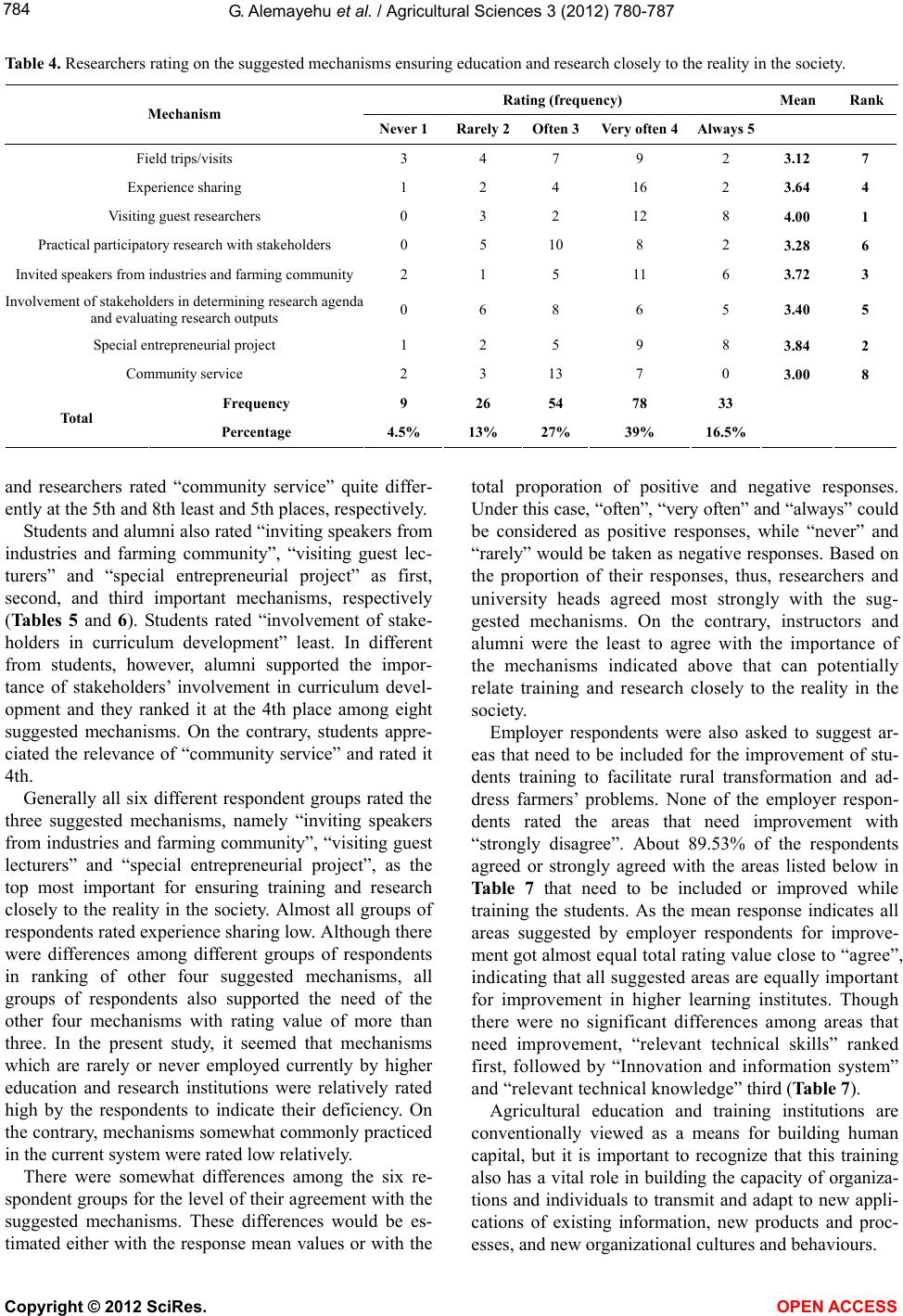 G. Alemayehu et al. / Agricultural Sciences 3 (2012) 780-787 784 Table 4. Researchers rating on the suggested mechanisms ensuring education and research closely to the reality in the society. Rating (frequency) Mean Rank Mechanism Never 1Rarely 2Often 3Very often 4Always 5 Field trips/visits 3 4 7 9 2 3.12 7 Experience sharing 1 2 4 16 2 3.64 4 Visiting guest researchers 0 3 2 12 8 4.00 1 Practical participatory research with stakeholders 0 5 10 8 2 3.28 6 Invited speakers from industries and farming community 2 1 5 11 6 3.72 3 Involvement of stakeholders in determining research agenda and evaluating research outputs 0 6 8 6 5 3.40 5 Special entrepreneurial project 1 2 5 9 8 3.84 2 Community service 2 3 13 7 0 3.00 8 Frequency 9 26 54 78 33 Total Percentage 4.5% 13% 27% 39% 16.5% and researchers rated “community service” quite differ- ently at the 5th and 8th least and 5th places, respectively. Students and alumni also rated “inviting speakers from industries and farming community”, “visiting guest lec- turers” and “special entrepreneurial project” as first, second, and third important mechanisms, respectively (Tab l es 5 and 6). Students rated “involvement of stake- holders in curriculum development” least. In different from students, however, alumni supported the impor- tance of stakeholders’ involvement in curriculum devel- opment and they ranked it at the 4th place among eight suggested mechanisms. On the contrary, students appre- ciated the relevance of “community service” and rated it 4th. Generally all six different respondent groups rated the three suggested mechanisms, namely “inviting speakers from industries and farming community”, “visiting guest lecturers” and “special entrepreneurial project”, as the top most important for ensuring training and research closely to the reality in the society. Almost all groups of respondents rated experience sharing low. Although there were differences among different groups of respondents in ranking of other four suggested mechanisms, all groups of respondents also supported the need of the other four mechanisms with rating value of more than three. In the present study, it seemed that mechanisms which are rarely or never employed currently by higher education and research institutions were relatively rated high by the respondents to indicate their deficiency. On the contrary, mechanisms somewhat commonly practiced in the current system were rated low relatively. There were somewhat differences among the six re- spondent group s for the level of their agreemen t with the suggested mechanisms. These differences would be es- timated either with the response mean values or with the total proporation of positive and negative responses. Und er this case, “often”, “ver y often” and “always” c ou ld be considered as positive responses, while “never” and “rarely” would be taken as negative responses. Based on the proportion of their responses, thus, researchers and university heads agreed most strongly with the sug- gested mechanisms. On the contrary, instructors and alumni were the least to agree with the importance of the mechanisms indicated above that can potentially relate training and research closely to the reality in the society. Employer respondents were also asked to suggest ar- eas that need to be included for the improvement of stu- dents training to facilitate rural transformation and ad- dress farmers’ problems. None of the employer respon- dents rated the areas that need improvement with “strongly disagree”. About 89.53% of the respondents agreed or strongly agreed with the areas listed below in Table 7 that need to be included or improved while training the students. As the mean response indicates all areas suggested by employer respondents for improve- ment got almost equal total rating value close to “agree”, indicating that all suggested areas are equally important for improvement in higher learning institutes. Though there were no significant differences among areas that need improvement, “relevant technical skills” ranked first, followed by “Innovation and information system” and “relevant technical knowledge” third (Table 7). Agricultural education and training institutions are conventionally viewed as a means for building human capital, but it is important to recognize that this training also has a vital role in building the capacity of organiza- tions and individuals to transmit and adapt to new appli- cations of existing information, new products and proc- sses, and new organizational cultures and behaviours. e Copyright © 2012 SciRes. OPEN ACCESS 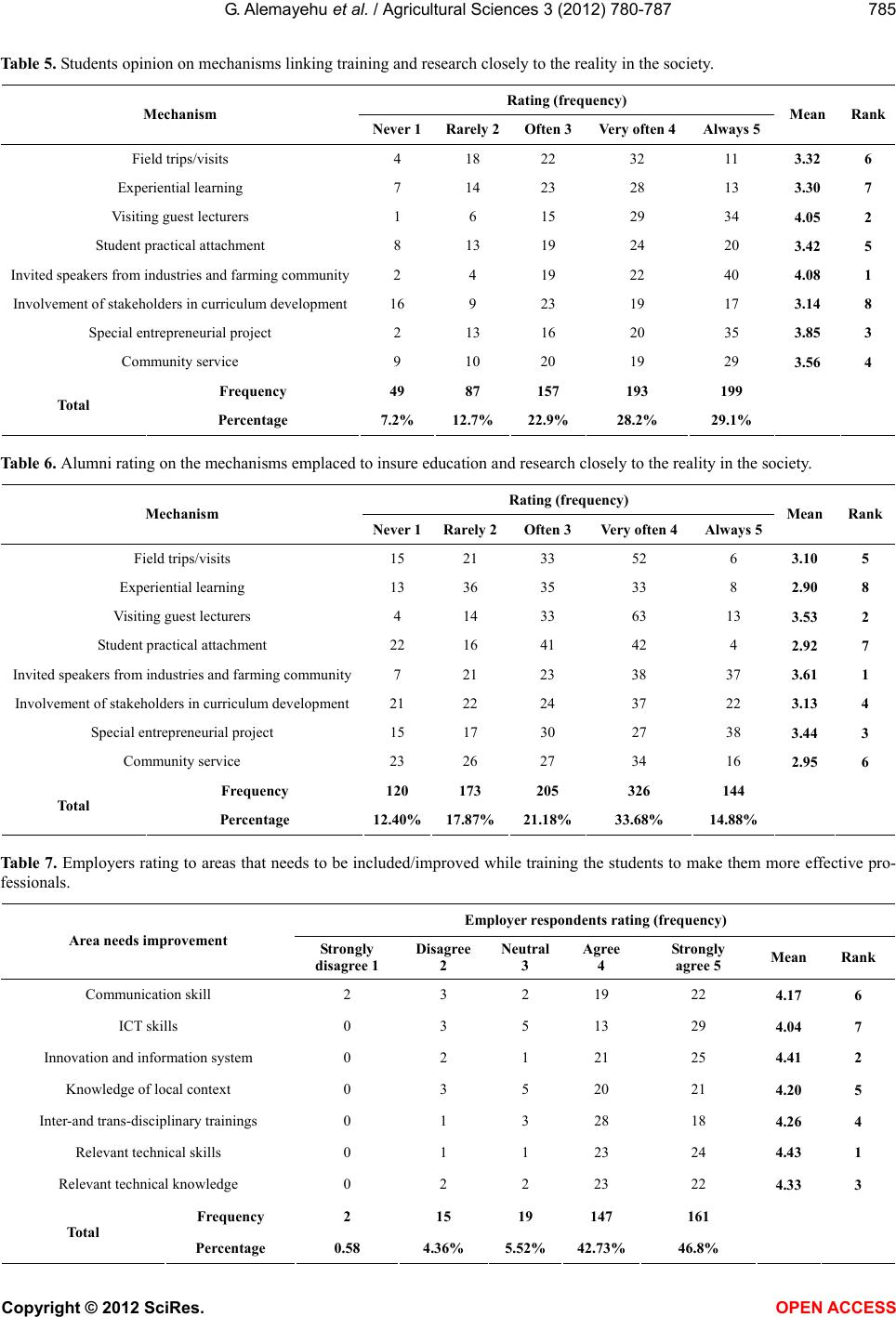 G. Alemayehu et al. / Agricultural Sciences 3 (2012) 780-787 785 Table 5. Students opinion on mechanisms linking training and research closely to the reality in the society. Rating (frequency) Mechanism Never 1Rarely 2Often 3Very often 4Always 5 Mean Rank Field trips/visits 4 18 22 32 11 3.32 6 Experiential learning 7 14 23 28 13 3.30 7 Visiting guest lecturers 1 6 15 29 34 4.05 2 Student practical attachment 8 13 19 24 20 3.42 5 Invited speakers from industries and farming community 2 4 19 22 40 4.08 1 Involvement of stakeholders in curriculum development 16 9 23 19 17 3.14 8 Special entrepreneurial project 2 13 16 20 35 3.85 3 Community service 9 10 20 19 29 3.56 4 Frequency 49 87 157 193 199 Total Percentage 7.2% 12.7% 22.9% 28.2% 29.1% Table 6. Alumni rating on the mechanisms emplaced to insure education and research closely to the reality in the society. Rating (frequency) Mechanism Never 1Rarely 2Often 3Very often 4 Always 5 Mean Rank Field trips/visits 15 21 33 52 6 3.10 5 Experiential learning 13 36 35 33 8 2.90 8 Visiting guest lecturers 4 14 33 63 13 3.53 2 Student practical attachment 22 16 41 42 4 2.92 7 Invited speakers from industries and farming community 7 21 23 38 37 3.61 1 Involvement of stakeholders in curriculum development 21 22 24 37 22 3.13 4 Special entrepreneurial project 15 17 30 27 38 3.44 3 Community service 23 26 27 34 16 2.95 6 Frequency 120 173 205 326 144 Total Percentage 12.40%17.87%21.18%33.68% 14.88% Table 7. Employers rating to areas that needs to be included/improved while training the students to make them more effective pro- fessionals. Employer respondents rating (frequency) Area needs improvement Strongly disagree 1 Disagree 2 Neutral 3 Agree 4 Strongly agree 5 Mean Rank Communication skill 2 3 2 19 22 4.17 6 ICT skills 0 3 5 13 29 4.04 7 Innovation and information system 0 2 1 21 25 4.41 2 Knowledge of local context 0 3 5 20 21 4.20 5 Inter-and trans-disciplinary trainings 0 1 3 28 18 4.26 4 Relevant technical skills 0 1 1 23 24 4.43 1 Relevant technical knowledge 0 2 2 23 22 4.33 3 Frequency 2 15 19 147 161 Total Percentage 0.58 4.36% 5.52% 42.73%46.8% Copyright © 2012 SciRes. OPEN ACCESS 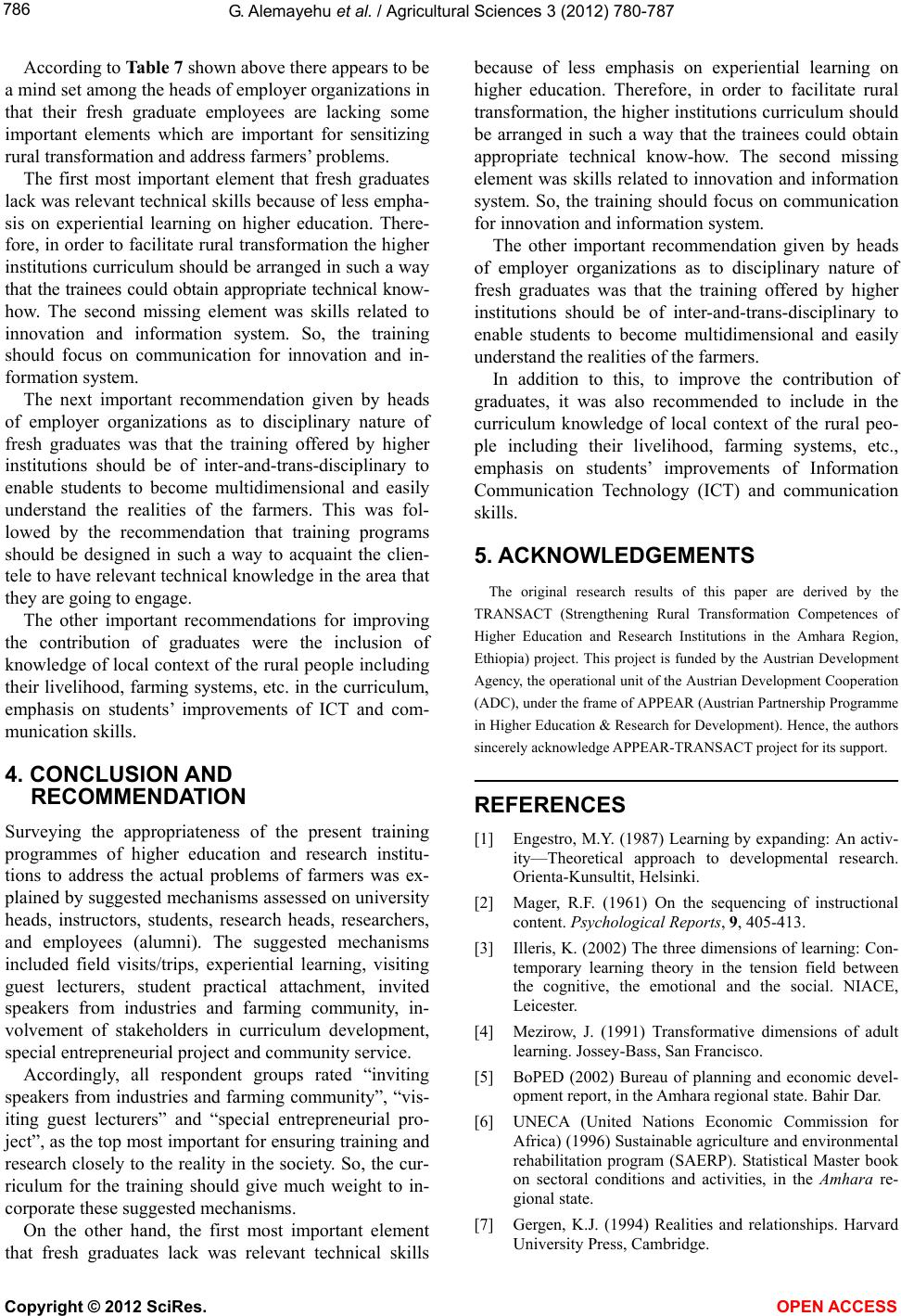 G. Alemayehu et al. / Agricultural Sciences 3 (2012) 780-787 786 According to Table 7 shown above there appears to be a mind set among the heads of employer organizations in that their fresh graduate employees are lacking some important elements which are important for sensitizing rural transformation and address farmers’ problems. The first most important element that fresh graduates lack was relevant technical skills because of less empha- sis on experiential learning on higher education. There- fore, in order to facilitate rural transformation the higher institutions curriculu m should be arranged in such a way that the trainees could obtain appropriate technical know- how. The second missing element was skills related to innovation and information system. So, the training should focus on communication for innovation and in- formation system. The next important recommendation given by heads of employer organizations as to disciplinary nature of fresh graduates was that the training offered by higher institutions should be of inter-and-trans-disciplinary to enable students to become multidimensional and easily understand the realities of the farmers. This was fol- lowed by the recommendation that training programs should be designed in such a way to acquaint the clien- tele to have relevant technical knowledge in the area that they are going to engage. The other important recommendations for improving the contribution of graduates were the inclusion of knowledge of local context of the rural people including their livelihood, farming systems, etc. in the curriculum, emphasis on students’ improvements of ICT and com- munication skills. 4. CONCLUSION AND RECOMMENDATION Surveying the appropriateness of the present training programmes of higher education and research institu- tions to address the actual problems of farmers was ex- plained by suggested mechanisms assessed on university heads, instructors, students, research heads, researchers, and employees (alumni). The suggested mechanisms included field visits/trips, experiential learning, visiting guest lecturers, student practical attachment, invited speakers from industries and farming community, in- volvement of stakeholders in curriculum development, special entrepreneurial project and community service. Accordingly, all respondent groups rated “inviting speakers from industries and farming community”, “vis- iting guest lecturers” and “special entrepreneurial pro- ject”, as the top most important for ensuring training and research closely to the reality in the society. So, the cur- riculum for the training should give much weight to in- corporate these suggested mechanisms. On the other hand, the first most important element that fresh graduates lack was relevant technical skills because of less emphasis on experiential learning on higher education. Therefore, in order to facilitate rural transformation, the higher institutio ns curriculum should be arranged in such a way that the trainees could obtain appropriate technical know-how. The second missing element was skills related to innovation and information system. So, the training should focus on communication for innovation and information system. The other important recommendation given by heads of employer organizations as to disciplinary nature of fresh graduates was that the training offered by higher institutions should be of inter-and-trans-disciplinary to enable students to become multidimensional and easily understand the realities of the farmers. In addition to this, to improve the contribution of graduates, it was also recommended to include in the curriculum knowledge of local context of the rural peo- ple including their livelihood, farming systems, etc., emphasis on students’ improvements of Information Communication Technology (ICT) and communication skills. 5. ACKNOWLEDGEMENTS The original research results of this paper are derived by the TRANSACT (Strengthening Rural Transformation Competences of Higher Education and Research Institutions in the Amhara Region, Ethiopia) project. This project is funded by the Austrian Development Agency, the operational unit of the Austrian Development Cooperation (ADC), under the frame of APPEAR (Austrian Partnership Programme in Higher Education & Research for Development). Hence, the authors sincerely acknowledge APPEAR-TRANSACT project for its support. REFERENCES [1] Engestro, M.Y. (1987) Learning by expanding: An activ- ity—Theoretical approach to developmental research. Orienta-Kunsultit, Helsinki. [2] Mager, R.F. (1961) On the sequencing of instructional content. Psychological Reports, 9, 405-413. [3] Illeris, K. (2002) The three dimensions of learning: Con- temporary learning theory in the tension field between the cognitive, the emotional and the social. NIACE, Leicester. [4] Mezirow, J. (1991) Transformative dimensions of adult learning. Jossey-Bass, San Francisco. [5] BoPED (2002) Bureau of planning and economic devel- opment report, in the Amhara regional state. Bahir Dar. [6] UNECA (United Nations Economic Commission for Africa) (1996) Sustainable agriculture and environmental rehabilitation program (SAERP). Statistical Master book on sectoral conditions and activities, in the Amhara re- gional state. [7] Gergen, K.J. (1994) Realities and relationships. Harvard University Press, Cambridge. Copyright © 2012 SciRes. OPEN ACCESS  G. Alemayehu et al. / Agricultural Sciences 3 (2012) 780-787 787 ACRONYMS AND TERMINOLOGIES 1) Amhara: One of the regions in Ethiopia located in the north western of the country; 2) Gondar: One of the zones in Amhara region lo- cated in the north west of it; 3) Bahir Dar: Capital city of Amhara region located in the north western of it; 4) ANRS: Amhara National Regional State; 5) Wor eda: District; 6) ARARI: Amhara Region Agricultural Research In- stitute; 7) Tigray, Oromia, Afar, Benishangul Gumuz: Na ti o n a l regional states in Ethiopia; 8) East Gojam, West Gojam, Awi, North Gondar, South Gondar, Wag Himra, North Wollo, South Wollo, North She wa: Adm inis trat ive zo nes in Amh ara reg ion; 9) DA: Development Agent (Extension worker work- ing with a farmer at a grass root level); 10) NGO: Non Government al Organization; 11) ICT: Informat i on Com munication Tec h nology; 12) UNDP: United Nations Development Program. Copyright © 2012 SciRes. OPEN ACCESS |

